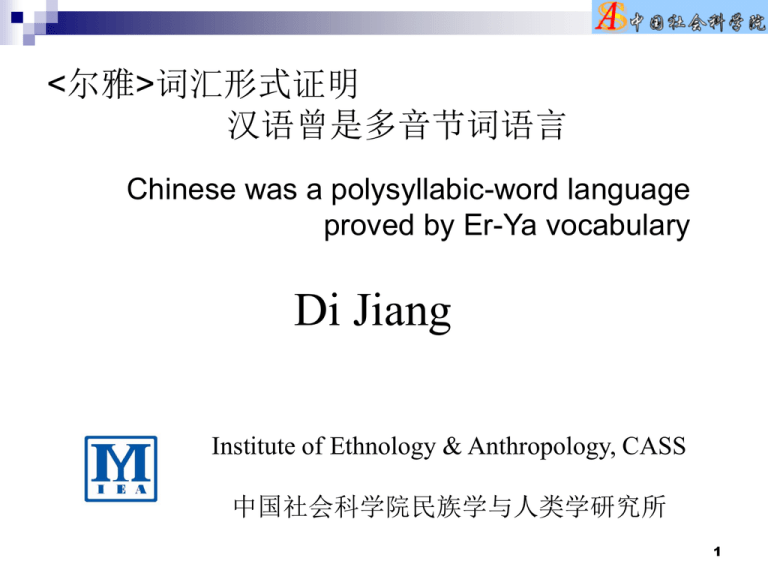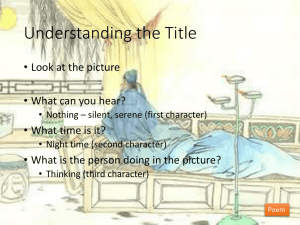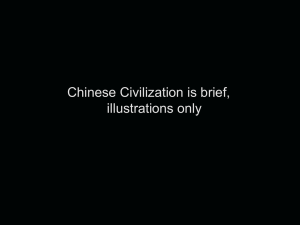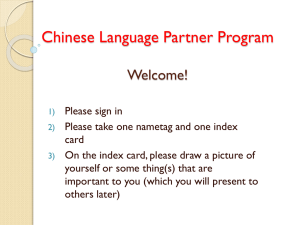Jiang, Di江荻 - 北京大学中国语言学研究中心
advertisement

<尔雅>词汇形式证明 汉语曾是多音节词语言 Chinese was a polysyllabic-word language proved by Er-Ya vocabulary Di Jiang Institute of Ethnology & Anthropology, CASS 中国社会科学院民族学与人类学研究所 1 Topics 汉语很奇怪 Is Chinese curious over the world? <尔雅>的名物词现象 the Mingwu words in <ErYa> 假说:汉语早期是多音节词语言 Hypothesis: Chinese was a polysyllabic-word language 抑扬词格模式及模式演化:达让语 the iambic pattern and its change: Example of Darang language <尔雅>普通词的单音节化 monosyllabization in <Er-Ya> <尔雅>名物词的专有名词性质及遗存 the particular proper name in <Er-Ya> and their survival 结语:早期汉语多音节词的证据 Mingwu words as the evidence of polysyllabic words in early Chinese Is Chinese surprising in word structures? Only Chinese and other languages in Southeast area are monosyllabic-word languages. Is Chinese a monster over the world languages? 纵观世界语言,仅有汉语为代表的东亚 和东南亚语言为单音节词语言,难道汉 语是世界语林中独生的怪胎吗? 这个问题涉及古代至现代汉语的各领域研究 为什么汉语缺乏形态(孤立语,语序重要)? 为什么汉语以复合法构词为主(词法和句法一致)? 为什么汉语感知以声韵母为单位(而不是元辅音)? 为什么汉语需要声调(声调语言)? 为什么汉字数千年来一脉相承,未走“形-意-音”发展道路? 3 When did Chinese begin? 现代科学界共识的观点是: 世界各地人群都是走出非洲的现代人后裔。 如果要证明汉语是走出非洲现代人带来的语言之后代语言 ,就得证明汉语并非自古就是单音节型语言。 If the hypothesis is that Chinese is a descendant language of modern human from Africa, it is necessary to prove its polysyllabic form far before Jiaguwen era (inscriptions on bones of the Shang Dynasty). 4 Example <Er-Ya> 《尔雅》共计19篇。 前3篇“释诂”“释言 ”“释训”注解普通 词语, 后16篇解释名物词。 5 Comparison of common words and Mingwu words “释诂”举例: 如、适、之、嫁、徂、 逝,往也。 赉、贡、锡、畀、予、 贶,赐也。 舒、业、顺,叙也。 “释草”举例: 萧,萩。 蒮,山韭。 购,蔏蒌。 茢,勃茢。 鵹黃,楚雀。 薢茩,芵茪 荨,海藻。 Common words in <ErYa> “释诂”双音节被释词仅占5.6%, “释言”双音节被释词仅占0.7%, 训释词1项(“畯,农夫也”)。 “释训”多为叠音词 The Chinese common words in pre-Qin days are monosyllabic. 7 Mingwu words in <ErYa>(1) “草木虫鱼鸟”:被释词单音节词多 8 Mingwu words in <ErYa>(2) “草木虫鱼鸟”:训释词双音节词多 9 “草木虫鱼鸟” 被释词与训释词数量比 被释词:单音节词比率高于多音节词,被 释词基本是单音节词,平均占69.7%, 训释词:多音节词高于单音节词。训释词 基本是多音节词,平均占75.8%, 10 Two questions in <ErYa> 为什么前3篇被释词和训释词很少有多音节词?后5篇有大 量多音节词? Why are there few polysyllabic words in first 3 volumes, and a lot of those in last 5 volumes? 为什么后5篇多音节训释词的比率远高于多音节被释词? Why are the explaining words much more than the explained words in last 5 volumes? 11 hypothesis 早期汉语或汉藏原始母语是多音节词语言 Chinese language in early Time was of polysyllable. 12 Iambic patterns Hayes(1985): the iambic-trochaic law Hayes, B. (1985). Iambic and Trochaic Rhythm in Stress Rules. H. Shorto(1960): minor syllables in mainland Southeast Asia. 指词根主音节前所带元音极度弱化的音节,“除 伴生元音外不带元音的音节”。 13 Change of Iambic patterns 潘悟云提出上古汉语有Cr-、Cl-和C-r-、Cl-两类复辅音声母的设想(1987)。 “从总体上看,东南亚语言大的发展趋势是从双音节的语素发展 为一个半音节,一个半音节再缩减为一个音节。”(1999) Brunelle, M. ; P. Pittayaporn(in print): The role of the iambic-trochaic law in iambicity and monosyllabization in Mainland Southeast Asia. 14 word structural change under the Iambic law Exampls of Darang language 15 Monosyllabization of the vocabulary in the first three volumes in ErYa <尔雅>前三篇被释词基本属于普通词语, 即所谓抽象概念、属性、状态、时空、行 为动作等词语。 <尔雅>前三篇数据表明普通词汇经历了抑 扬格词模式演化过程,即:单音节词化。 16 the nature of the vocabularies in last 5 volumes 表示有一定数量集成并相互区别的具体事 物,训诂学家称为名物词 被释词 蠖, 茢, 蠓, 鸤鸠, 蚹蠃, 训释词 蚇蠖 勃茢 蠛蠓 鴶鵴 螔蝓 被释词 训释词 蜩, 蜋蜩 杞, 枸檵 戎叔, 荏菽 淔灌, 苬芝 螟蛉, 桑蟲 17 Mingwu words are particular proper name 名物词是客观世界多样性的表现 名物词具有专有名词的惟一性特征 专有名词具有更强的抗演化的力量 因此: 名物词在抑扬格词模式演化过程中不同程 度地保留下来。 18 Data statistics between explained and explaining words 19 Data statistics between explained and explaining words 20 Researching Background 江 荻 2012 王念孙的联绵词‘天籁’说证。当代语言科 学创新与发展国际研讨会暨<语言科学>十周年庆典会,大 会演讲报告(江苏师范大学,2012-10-27) 江荻: 人类语言基因的演化和世界语言词形多样性 复旦大学生命科学院 演讲报告, 2012.5.18 中国社会科学院中国少数民族语言研究中心‘研究员 报告日’演讲(2012-06-13) Poster, CIEL2012: Kang, Caijun, Yan, Haixiong, Jiang Di: Diversity Evolution of word-syllabic structures. 21 Conclusion 遗传人类学从基因科学角度提出现代人起源于非 洲的命题,这些带着语言走出非洲的现代人逐步 扩散到世界各地,语言也在世界或聚集或扩散演 化开来。 把汉语放在这个大背景下来思考,尽管甲金文时 代汉语已经普遍单音节词化,仍能发现不少多音 节词遗留的痕迹。 22 Conclusion 战国末期的<尔雅>名物词正是早期汉语或 汉藏母语多音节词的证据。 The survival evidence for early Chinese as polysyllabic language are Mingwu words of <ErYa> in the end of Warring States Period in China. 23 谢谢!Thank you! 请批评指正 24 Poster 25 Model of Offset variances 26 Group by Offset variances 偏移量方差聚类 27 根据Shannon-Wiener多样性计算模型 s H Pi ln Pi i 1 28 average length of word-syllabic structures (AveWSSLength), average values of Offset (AveOFFset), Offset variances (OV), Diversity index (DI), Evenness index (EI), Dominant concentration index (DCI), AveWSSL AveOF Fset Yoruba 2.6525 0.3270 9 Swahili 2.4058 21 Persian 32 N. language 4 OV DI EI DCI 0.1639 2.2701 0.6611 0.2139 0.1548 0.0698 2.3373 0.7092 0.1904 3.1294 0.3687 0.1825 2.9798 0.8450 0.0919 Amis 3.1471 0.2175 0.0850 2.4312 0.7553 0.1370 45 eastern fijian 2.4550 0.0824 0.0392 2.2273 0.6427 0.2276 56 Vietnamese 1.5121 0.2343 0.1234 1.1215 0.4870 0.4139 92 Icelandic 3.0531 0.4239 0.2273 3.1646 0.8467 0.0568 98 English 2.2802 0.4562 0.2635 2.1049 0.6914 0.2032 114 Lakota 2.4879 0.1411 0.0626 2.5006 0.7426 0.1425 121 Mixtec 2.4315 0.2125 0.0947 2.5783 0.7252 0.1523 Offset variances for 4 groups 30






